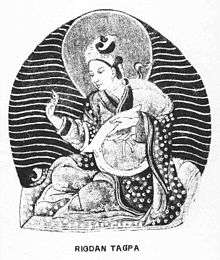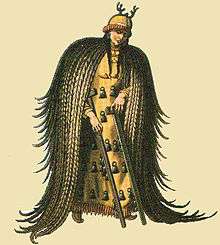Shambhala

In Hinduism and Tibetan Buddhist tradition Shambhala (Sanskrit: शम्भलः Śambhalaḥ, also spelled Shambala or Shamballa; Tibetan: བདེ་འབྱུང, Wylie: bde 'byung ; Chinese: 香巴拉; pinyin: xiāngbālā) is a mythical kingdom. The kingdom is said to be laid out in precisely the same form as an eight-petalled lotus blossom surrounded by a chain of snow mountains. At the centre lies the palace of the King of Shambala who governed from the city called Kalapa. Shambhala is also often called Shangri-la in some texts. [2]
Shambhala is mentioned in various ancient texts, including the Kalacakra Tantra[3] and the ancient Zhangzhung texts of western Tibet. The Bon scriptures speak of a closely related land called Tagzig Olmo Lung Ring.[4]
Hindu texts such as the Vishnu Purana (4.24) mention the village Shambhala as the birthplace of Kalki, the final incarnation of Vishnu, who will usher in a new Age (Satya Yuga).[5]
Whatever its historical basis, Shambhala (spelling derived from Buddhist transliterations) gradually came to be seen as a Buddhist pure land, a fabulous kingdom whose reality is visionary or spiritual as much as physical or geographic. It was in this form that the Shambhala myth reached Western Europe and the Americas, where it influenced non-Buddhist as well as Buddhist spiritual seekers—and, to some extent, popular culture in general.
In the Buddhist Kalachakra teachings

Shambhala is ruled over by Maitreya, the future Buddha. The Kalacakra tantra prophesies that when the world declines into war and greed, and all is lost, the 25th Kalki king will emerge from Shambhala with a huge army to vanquish "Dark Forces" and usher in a worldwide Golden Age. Using calculations from the Kalachakra Tantra, Alex Berzin puts this date at 2424.[6]
Manjuśrīkīrti is said to have been born in 159 BC and ruled over a kingdom of 300,510 followers of the Mlechha religion, some of whom worshipped the sun. He is said to have expelled 20,000 people from his domain who clung to 'Surya Samadhi' (sun realization) rather than convert to Kalachakra (Wheel of Time) Buddhism.

These expelled Rishis, seers, sages and saints, who had realized truth and eternal knowledge exclaimed, "We want to remain true to our Sun-Chariot. We do not wish to give up our belief system to change to another." This shows there may have been a fundamental difference between the 2 time-cycle-based doctrines. After realizing these were the wisest and best of his people and how much he was in need of them, he later asked them to return. Some did. Those who did not return were said to have set up another magical city elsewhere, the Shambhallah of mystic legend. Manjuśrīkīrti initiated the preaching of the Kalachakra teachings in order to try to convert those who returned and all still under his rule. In 59 BC he abdicated his throne to his son, Puṇḍārika, and died soon afterward, entering the sambhogakaya of buddhahood and was made a posthumous Buddhist saint.[7][8]
Western receptions and interpretations
Some westerners have been fascinated with the idea of Shambhala, often based on fragmentary accounts from the Kalachakra tradition. Tibet and its ancient traditions were largely unknown to westerners until the twentieth century; whatever little information westerners received was haphazard at best.[9]
The first information that reached western civilization about Shambhala came from the Portuguese Catholic missionary Estêvão Cacella, who had heard about Shambhala (which he transcribed as "Xembala"), and thought it was another name for Cathay or China. In 1627 they headed to Tashilhunpo, the seat of the Panchen Lama and, discovering their mistake, returned to India.[10]
In Altai Mountains folklore Mount Belukha is also believed to be a gateway to Shambhala.[11]
The Hungarian scholar Sándor Kőrösi Csoma, writing in 1833, provided the first geographic account of "a fabulous country in the north...situated between 45' and 50' north latitude". Due north from India to between these latitudes is eastern Kazakhstan, which is characterized by green hills, low mountains, rivers, and lakes. This is in contrast to the landscape of the provinces of Tibet and Xinjiang in western China, which are high mountains and arid.
Theosophy
During the late-19th century, Theosophical Society co-founder Helena Blavatsky alluded to the Shambhala myth, giving it currency for Western occult enthusiasts. Blavatsky, who claimed to be in contact with a Great White Lodge of Himalayan Adepts, mentions Shambhala in several places, but without giving it especially great emphasis.
Later esoteric writers further emphasized and elaborated on the concept of a hidden land inhabited by a hidden mystic brotherhood whose members labor for the good of humanity. Alice A. Bailey claims Shamballa (her spelling) is an extra-dimensional or spiritual reality on the etheric plane, a spiritual centre where the governing deity of Earth, Sanat Kumara, dwells as the highest Avatar of the Planetary Logos of Earth, and is said to be an expression of the Will of God.[12]
Expeditions
Nicholas and Helena Roerich led a 1924–1928 expedition aimed at Shambhala.[13]
Inspired by Theosophical lore and several visiting Mongol lamas, Gleb Bokii, the chief Bolshevik cryptographer and one of the bosses of the Soviet secret police, along with his writer friend Alexander Barchenko, embarked on a quest for Shambhala, in an attempt to merge Kalachakra-tantra and ideas of Communism in the 1920s. Among other things, in a secret laboratory affiliated with the secret police, Bokii and Barchenko experimented with Buddhist spiritual techniques to try to find a key for engineering perfect communist human beings.[14] They contemplated a special expedition to Inner Asia to retrieve the wisdom of Shambhala - the project fell through as a result of intrigues within the Soviet intelligence service, as well as rival efforts of the Soviet Foreign Commissariat that sent its own expedition to Tibet in 1924.
Modern times
French Buddhist Alexandra David-Néel associated Shambhala with Balkh in present-day Afghanistan, also offering the Persian Sham-i-Bala, "elevated candle" as an etymology of its name.[15] In a similar vein, the Gurdjieffian J. G. Bennett published speculation that Shambalha was Shams-i-Balkh, a Bactrian sun temple.[16]
In Western culture
Shambhala may have been the inspiration for Shangri-La, a paradise on Earth hidden in a Tibetan valley, which features in the 1933 novel Lost Horizon by British author James Hilton.[17]
See also
Footnotes
- ↑ Crossman, Sylvie and Jean-Pierre Barou, eds. Tibetan Mandala, Art and Practice (The Wheel of Time). New York: Konecky & Konecky, 2004. ISBN 1-56852-473-0. pp.20-26
- ↑ Leepage, V (1996) Shambhala: The Fascinating Truth Behind the Myth of Shangri-la. Theosophical Publishing House, Illinois.pp 23-4
- ↑ The Tantra by Victor M. Fic, Abhinav Publications, 2003, p.49.
- ↑ The Bon Religion of Tibet by Per Kavǣrne, Shambhala, 1996
- ↑ LePage, Victoria (1996). Shambhala: The Fascinating Truth Behind the Myth of Shangri-La. Quest Books. pp. 125–126. ISBN 9780835607506.
- ↑ Berzin, Alexander (1997). "Taking the Kalachakra Initiation". Retrieved 2016-06-20.
- ↑ Das, Sarat Chandra (1882). Contributions to the Religion and History of Tibet, in Journal of the Asiatic Society of Bengal, Vol. LI. Reprint: Manjushri Publishing House, Delhi. 1970, pp. 81–2.
- ↑ Edwin Bernbaum "The Way to Shambhala: A Search for the Mythical Kingdom Beyond the Himalayas" 1980 & Albert Grünwedel "Der Weg nach Shambhala" 1915
- ↑ Lopez, Donald S. Jr. Prisoners of Shangri~La, Tibetan Buddhism and the West, The University of Chicago Press, 1998
- ↑ Bernbaum, Edwin. (1980). The Way to Shambhala, pp. 18-19. Reprint: (1989). Jeremy P. Tarcher, Inc., Los Angeles. ISBN 0-87477-518-3.
- ↑ aprilholloway. "Mysteries of the Kingdom of Shambhala".
- ↑ Bailey, Alice A, A Treatise on Cosmic Fire 1932 Lucis Trust. 1925, p 753
- ↑ Archer, Kenneth. Roerich East & West. Parkstone Press 1999, p.94
- ↑ Znamenski (2011)
- ↑ David-Néel, A. Les Nouvelles littéraires ;1954, p.1
- ↑ Bennett, J.G: "Gurdjieff: Making a New World". Bennett notes Idries Shah as the source of the suggestion.
- ↑ Wood, Michael (17 February 2011). "BBC - History - Ancient History in depth: Shangri-La". BBC. Retrieved 28 February 2018.
References
- Rock Opera "Szambalia" ("Shambhala") (2014). Official premiere in Poland, Warsaw (24.06.2014)
- Rock song "Halls of Shambala" by B. W. Stevenson, covered and popularized by the rock band Three Dog Night Shambala (song)
- Berzin, Alexander (2003). Study Buddhism. Mistaken Foreign Myths about Shambhala.
- Martin, Dean. (1999). "'Ol-mo-lung-ring, the Original Holy Place." In: Sacred Spaces and Powerful Places In Tibetan Culture: A Collection of Essays. (1999) Edited by Toni Huber, pp. 125–153. The Library of Tibetan Works and Archives, Dharamsala, H.P., India. ISBN 81-86470-22-0.
- Meyer, Karl Ernest and Brysac, Shareen Blair (2006) Tournament of Shadows: The Great Game And the Race for Empire in Central Asia ISBN 0-465-04576-6
- Bernbaum, Edwin. (1980). The Way to Shambhala: A Search for the Mythical Kingdom Beyond the Himalayas. Reprint: (1989) St. Martin's Press, New York. ISBN 0-87477-518-3.
- Jeffrey, Jason. Mystery of Shambhala in New Dawn, No. 72 (May–June 2002).
- Trungpa, Chogyam. Shambhala: The Sacred Path of the Warrior. Shambhala Publications. ISBN 0-87773-264-7
- Znamenski, Andrei. (2011). Red Shambhala: Magic, Prophecy, and Geopolitics in the Heart of Asia. Quest Books, Wheaton, IL (2011) ISBN 978-0-8356-0891-6.
- "Tibetan Buddhist Atrocities and Propaganda." Dr. S. D'Montford. "Tibetan Buddhist Atrocities and Propaganda." Happy Medium Publishing. Sydney. 2004
- Allen, Charles. (1999). The Search for Shangri-La: A Journey into Tibetan History. Little, Brown and Company. Reprint: Abacus, London. 2000. ISBN 0-349-11142-1.
- Znamenski, Andrei. Red Shambhala: Magic, Prophecy, and Geopolitics in the Heart of Asia. Wheaton, IL: Quest Books, 2011. ISBN 978-0-8356-0891-6
- Martin, Dan. (1999). "'Ol-mo-lung-ring, the Original Holy Place." In: Sacred Spaces and Powerful Places In Tibetan Culture: A Collection of Essays. (1999) Edited by Toni Huber, pp. 125–153. The Library of Tibetan Works and Archives, Dharamsala, H.P., India. ISBN 81-86470-22-0.
- Symmes, Patrick. (2007). "The Kingdom of the Lotus" in Outside, 30th Anniversary Special Edition, pp. 148–187. Mariah Media, Inc., Red Oak, Iowa.